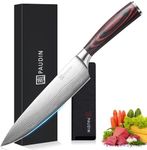Buying Guide for the Best Chef Knives
Choosing the right chef knife is crucial for any cooking enthusiast or professional chef. A good chef knife can make food preparation easier, faster, and more enjoyable. When selecting a chef knife, it's important to consider several key specifications to ensure you find the best fit for your needs. Here are the most important factors to consider and how to navigate them.Blade MaterialThe blade material of a chef knife affects its sharpness, durability, and ease of maintenance. Common materials include stainless steel, high-carbon steel, and ceramic. Stainless steel is resistant to rust and easy to maintain, making it a good choice for home cooks. High-carbon steel is extremely sharp and holds its edge well but requires more maintenance to prevent rust. Ceramic blades are very sharp and lightweight but can be brittle and prone to chipping. Choose a blade material based on your willingness to maintain the knife and your preference for sharpness and durability.
Blade LengthBlade length typically ranges from 6 to 12 inches. A shorter blade (6-8 inches) offers more control and is easier to handle, making it suitable for smaller hands or those new to cooking. A longer blade (8-12 inches) can handle larger tasks and is preferred by experienced chefs for its versatility. Consider the types of food you prepare and your comfort level with handling a knife when choosing the blade length.
Blade ShapeThe shape of the blade can influence how the knife performs different tasks. A curved blade is ideal for rocking motions, making it great for chopping herbs and vegetables. A straight blade is better for slicing and dicing. Some knives have a combination of both, offering versatility. Think about the primary tasks you will use the knife for and choose a blade shape that complements those tasks.
Handle MaterialHandle material affects the grip, comfort, and durability of the knife. Common materials include wood, plastic, and composite. Wood handles offer a traditional feel and good grip but require more maintenance. Plastic handles are durable and easy to clean but may not provide the same level of grip. Composite handles combine the best of both worlds, offering durability and a good grip. Choose a handle material that feels comfortable in your hand and suits your maintenance preferences.
Weight and BalanceThe weight and balance of a chef knife can significantly impact its ease of use. A well-balanced knife feels comfortable and stable in your hand, making it easier to control. Heavier knives can provide more power for cutting through tough ingredients, while lighter knives offer more agility and reduce hand fatigue. Test the knife in your hand to see how it feels and choose one that offers a good balance for your strength and cooking style.
Edge TypeThe edge type of a chef knife determines its cutting performance and maintenance needs. Common edge types include straight, serrated, and granton. Straight edges are versatile and easy to sharpen, making them suitable for most tasks. Serrated edges are great for cutting through tough or crusty surfaces but are harder to sharpen. Granton edges have small indentations that reduce friction and prevent food from sticking, ideal for slicing. Consider the types of food you prepare and how often you are willing to sharpen the knife when choosing the edge type.








![Kimura Chef Knife, [Made in Japan],](https://images-proxy.bestreviews.guide/Po8izm6qT4zd_ftn9TIO3wbUIVQ=/0x150/https://m.media-amazon.com/images/I/41E4HLBFNgL._AC_CX679_.jpg)






